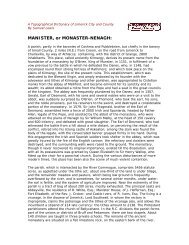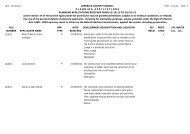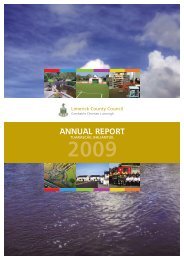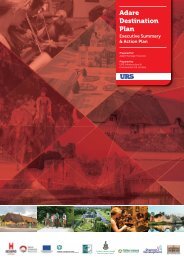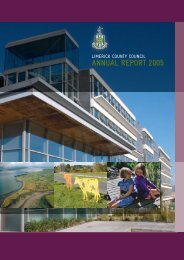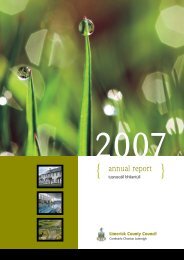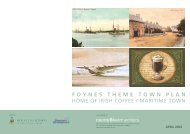Rural Design Advice for Individual Houses in the Countryside
Rural Design Advice for Individual Houses in the Countryside
Rural Design Advice for Individual Houses in the Countryside
Create successful ePaper yourself
Turn your PDF publications into a flip-book with our unique Google optimized e-Paper software.
4.PLANNING THE SITEBuild<strong>in</strong>g OrientationSusta<strong>in</strong>able Site Plann<strong>in</strong>gOrientation is concerned with <strong>the</strong> location of <strong>the</strong>proposed house <strong>in</strong> relation to views (both to and from <strong>the</strong>site) and to <strong>the</strong> elements (w<strong>in</strong>d direction and path of <strong>the</strong>sun). The most acceptable site layout needs to achieve anumber of often conflict<strong>in</strong>g considerations, such as viewsand prospects, climate, shelter, privacy, and m<strong>in</strong>imis<strong>in</strong>gimpact on <strong>the</strong> surround<strong>in</strong>gs.Whereas orientat<strong>in</strong>g a house to take full advantage ofviews can be of benefit to <strong>the</strong> owner, this may well result<strong>in</strong> <strong>the</strong> house be<strong>in</strong>g over-conspicuous <strong>in</strong> <strong>the</strong> landscape.Sometimes a partial or glimpsed view outwards maysuffice, framed by vegetation or <strong>the</strong> local topography.Elsewhere it may be necessary to orientate <strong>the</strong> house sothat just a specific part of it has access to <strong>the</strong> view (e.g.from a gable end).A thorough site appraisal is required to ensure that viewsboth of and from <strong>the</strong> property are considered from avariety of different vantage po<strong>in</strong>ts.Be<strong>in</strong>g more efficient <strong>in</strong> how we use energy <strong>in</strong> our dailylives can strongly <strong>in</strong>fluence <strong>the</strong> selection of a site. Manydecisions affect<strong>in</strong>g <strong>the</strong> energy per<strong>for</strong>mance of a houseneed to be taken early <strong>in</strong> <strong>the</strong> site plann<strong>in</strong>g and designprocess. Consider<strong>in</strong>g <strong>in</strong>creased energy efficiency at anearly stage can also have immediate benefits such as: Sav<strong>in</strong>g money on electricity and heat<strong>in</strong>g bills; Creat<strong>in</strong>g a more com<strong>for</strong>table and convenient home;and Mak<strong>in</strong>g a vital contribution to reduc<strong>in</strong>g climatechange.Energy Per<strong>for</strong>manceThe EU Directive on <strong>the</strong> Energy Per<strong>for</strong>mance ofBuild<strong>in</strong>gs requires every home <strong>for</strong> sale or rent <strong>in</strong> Irelandto be rated as to its energy per<strong>for</strong>mance. This must bedeterm<strong>in</strong>ed and demonstrated <strong>in</strong> two dist<strong>in</strong>ct ways - allnew dwell<strong>in</strong>gs must address both: Build<strong>in</strong>g Regulations Technical Guidance Document - LBuild<strong>in</strong>g <strong>for</strong>m arranged to create shelter and privacyThe Build<strong>in</strong>g Regulations require that all houses areconstructed to m<strong>in</strong>imum standards of materials,workmanship, services and energy consumption. TheTechnical Guidance Documents (TGD) give <strong>in</strong>structionand guidance on <strong>the</strong> manner <strong>in</strong> which compliance with<strong>the</strong> build<strong>in</strong>g regulation can be made. TGD – L concernsenergy use and CO 2 emissions from build<strong>in</strong>gs. Theprimary method of demonstrat<strong>in</strong>g compliance with <strong>the</strong>build<strong>in</strong>g regulation under TGD – L is by m<strong>in</strong>imis<strong>in</strong>g CO 2emissions associated with energy consumption <strong>in</strong> <strong>the</strong>build<strong>in</strong>g. The method of determ<strong>in</strong><strong>in</strong>g <strong>the</strong> energy and CO 2per<strong>for</strong>mance is <strong>the</strong> Domestic Energy AssessmentProcedure (DEAP).Build<strong>in</strong>g Energy Rat<strong>in</strong>gThe EU Directive on <strong>the</strong> Energy Per<strong>for</strong>mance ofBuild<strong>in</strong>gs requires every new home constructed, sold orrented must be rated as to its energy & CO 2per<strong>for</strong>mance. New houses constructed after 2007 shouldhave a BER of B1 or better.34.County Limerick: <strong>Rural</strong> <strong>Design</strong> <strong>Advice</strong> <strong>for</strong> <strong>Individual</strong> <strong>Houses</strong> <strong>in</strong> <strong>the</strong> <strong>Countryside</strong>



